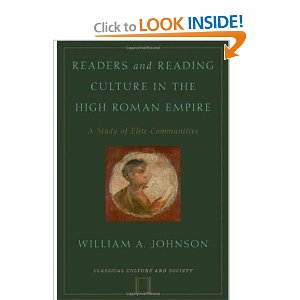In the American world of bigger is better (and more erudite) it is refreshing to find a smallish book (207 pages of text, including some pictures) that makes its points in detail with full primary source documentation and then resists the tendency to be verbose or erudite for all the wrong reasons— namely self-display (although there are some words in this book which are over the top—- e.g. lacunose comes up repeatedly). William A. Johnson is a classics scholar at Duke and a very good one indeed paying attention to detail and offering careful analysis. His focus in ‘Readers and Reading Culture in the High Roman Empire’ (Oxford, 2010) is on elite reading circles in the High Roman Empire (the 2nd-4th centuries). In other words, his focus is on texts, manuscripts, readers, and reading circles precisely during the period when Christianity was growing rapidly and producing an abundance of texts and manuscripts of various sorts. Let me be clear that this book focuses on people like Pliny or Aulus Gellius or Galen, or Fronto or Lucian, but there is much to be learned from this book that can be applied, mutatis mutandis to literate Christians, their scribes, and early Christian communities of reading and writing.
In the first place, Johnson helpfully reminds us, once again, that the ancient world was very like the modern era when it comes to texts, manuscripts, publishing anything, readers, or literacy for that matter. Literacy, if it went at all beyond the bare bones of being able to read and write, was the provenance of the elites of ancient society, especially when it came to the production of reasonably literate texts. Johnson is well aware of this, which is why he rightly focuses on elite reading circles. It will be useful here to share some of his insights. He begins by dealing with the old debate as to whether the ancients ever read silently, or if all reading was outloud. He is able to show that there is evidence of some silent and private reading, but not much. Most ancient reading was out loud, and indeed most ancient texts were oral texts, by which I mean written to be read outloud so their oral and aural features can be appreciated. The question that needs to be asked about texts in antiquity is how and for whom do they function in a largely illiterate and oral culture? And the answer is, they mostly are produced by, and function for the literate elites, unless we are talking about those small business scoundrels called booksellers, who existed in some of the large cities in the Roman Empire. And here is where it gets interesting. Even the elite literate had scribes or scholars or slaves to read to them rather than doing the dirty work themselves.
Ancient texts were indeed written in scriptum continuum and one had to be learned to be able to read such a contentious flow of Greek or Latin letters well out loud, one had to know the text already in some cases, and indeed real scribes and scholars were in the business of memorizing purple passages in important texts, and being able to locate them quickly with a stylus in the bookroll, despite the profusion of words. But when did the ancients read?
Johnson cites a text from Pliny the Younger talking about Pliny the elder and his desire for reading ‘efficency’ which is to say a sort of reading that doesn’t require a lot of hard work of looking up words, or trying to divide the syllables and sentences and the like, which is painstaking and time consuming. In Letter 3.5 he describes how his uncle had a lector read to him over meals, and he scolds a friend who makes the lector slow down to repeat a mispronounced word. When he is taking a bath, he has a book read to him, or he dictates notes, and he travels with a secretary who performs these same functions, and so not surprisingly he prefers to ride in a litter with the secretary rather than walking, to be able to more easily do his listening and processing and producing of texts. “When Pliny looks for increased efficiency in his study, silent reading is not, as for us, the natural solution.” (p. 14). Johnson is exercised in this study to exorcise modern notions of how ancient scholars must have worked, particularly he wants to banish the ‘isolated scholar in his ivory tower working alone’ model. Reading was largely a social activity in antiquity, whether public or private reading, and there was a considerable focus on the oral and rhetorical dimensions of reading, which meant reading out loud was the norm.
In his second chapter, Johnson deals with the process of ancient reading and producing of texts. Literary texts were usually produced in double column with considerable margins and space down between the columns as well, though there are plenty of early Christian manuscripts where there was only a single column with margins. The production of a bookroll made out of papyrus, if we are talking about some non-commerical text was done with an attention to form and style as well as content. The text was produced left to right in columns with a slight tilt of the script to the right, done in a fair legible hand, and in distinct letters (non-cursive) to make it easier to read.
Bookrolls were generally the product of scribes, not of private persons. “Making a bookroll involved no more than taking a premanufactured papyrus roll, writing out the text, attaching additional fresh rolls as the length of the text required, and when finished, cutting off the blank remainder.” (p. 18). Or not. It is entirely possible that what happened with Mark’s Gospel is that the original ending of only a few verses about seeing the risen Jesus after Mk. 16.8 was lost, since the outermost edge of the end of the text was left exposed to the elements (no they didn’t heed the exhortation— be kind and rewind, that we used to hear during the videotape era), so more papyrus was added to the end, and the result was the production of no less than three alternative endings, including the so called long ending of Mk. 16.9ff. (of course here in Kentucky it can only be seen as bad news that Mk. 16.9ff is not an original part of Mark’s Gospel since it provides the only possible endorsement of snake handling and poision drinking as tests of faith).
Were there any aids to the reader in the text in regard to parsing all this continuous flow of letters? In fact, very few were added. There might be a straight line extending into a margin to indicate a paragraph break, and there might be breathing marks to help with pronunciation, but little else in a typical scroll. Yea verily no chapters and verses and no separation of words. Chapters and verses were introduced into the copying of Biblical manuscripts by Archbishop Langton of Canterbury, when he had far too much time on his hands, and frankly he botched a good deal of the divisions— Heb. 12.1-3 goes with Heb. 11, not with what follows, to give but one examples. The chapters and verses are later aids added to the text, not parts of the original inspired texts of the Biblical writers.
Johnson describes the bookroll as an icon of elitism (p. 26), and he is right about this. And texts required not only scribes but lectors, those who could read the text fluently. Sometimes slaves served as lectors, but this was a different function from being a scribe, and a still different function from being a scholar. In part because texts were rare and precious and expensive, and written in scriptum continuum or as Johnson calls it scriptio continua training children to read focused on their memorizing Greek and Latin syllables, not merely letters. That way when they looked at a continuous flow of letters their minds were condition to see at least syllables if not words in the maze of letters.
And though it comes as something of a surprise to us, the function of becoming literate was not so one could read silently for one’s own benefit, but so one could become part of a community of readers who read to each other out loud and as Quintilian urges the goal is to become an orator, a rhetor, and so eloquent. “Reading out loud is intimately tied up with learning the phrasing– for everyone, not just budding orators– and phrasing is naturally linked with accurate apprehension of the meaning of the text.” (p. 29). Quintilian himself says “As regards reading, it is only possible to show in actual practice such things as knowing when to take a breath, where to place a pause in a line, where a new sentences ends of begins, when the voice ought to be raised or lowered, what inflection should be used with each phrase, and what should be spoken more quickly or more slowly….[In order to do all this] “he must [already] understand” the text (Inst. Or. 1.8.1-2).
Exactly, and so the notion that Paul would just send letters off to be deciphered afresh by bewildered semi-literate converts is a nonsense. This is not how ancient literary texts were normally treated. To the contrary, it is far more likely that Paul had someone take the text his scribe had written, already knowing its contents, and then orally deliver the text at the destination, with full ability to comment on and explain the text. Otherwise, it was just a bewildering maze of letters that could be parsed in various ways. Texts in an oral culture do not function like texts in our world.
Texts that are worthwhile or important would not merely be read out once, but repeatedly read, repeatedly digested, and in part would be memorized, and the first person to do this would be the lector, tasked with delivering the text orally at the destination. Notice for example the distinction made between ‘the reader’ (singular) in Rev. 1.3 and the hearers (plural) to whom he would speak. The reader is not the audience! The reader is the emissary of John of Patmos, sent to orally deliver his apocalypse not just once, but to seven different churches. That’s a lot of reading. What is striking about early Christianity is the sheer volume of texts, some of which bear the marks of eloquence in Greek. The social world of early Christianity involved learning circles, some literate leaders or readers, and their texts were oral texts.
One of the major emphases in Johnson’ study is that “Reading in this society is tightly bound up in the construction of the community. Group reading and serious conversation devolving from reading are twin axes around which much of the elite man’s community turns.” (p. 39). In other words, reading of texts creates community. It is highly likely that the earliest Christians read out their documents over meals shared together or as part of the symposium that would follow the dining, just as normal Greco-Roman literate persons did. The difference of course was the religious focus and content of the documents, but the process of delivery and consumption of information was the same.
But what about the production and publication of texts? Here the chapters on Pliny and Galen are especially helpful (pp.53ff.) “In Roman society, there was no publisher or other agent who acted as a gatekeeper for publicatrions…Since there were no publishers (in the modern sense) the only clear route to recognition as an author was by attachment to and promotion by one of these [literary] circles.” (p,53). This caused a problem for someone like Paul who could not allow himself to become the in house paided after dinner speaker of a Corinthian or Philippian or Ephesian convert, because that produced ongoing entangling social alliances and expectations, and Paul needed to be free to come and go as God led.
Patronage in some cases, if you were itinerant in task, had to be avoided. Such a dilemma did not apparently confront someone like Luke, who appears likely to have had a patron— named Theophilus to whom and for whom he wrote two of the largest ever early Christian documents, making up a third and more of the NT. What we need to realize about a massive document like Luke’s Gospel (over 39,000 Greek words) is that it presupposes an audience who is both literate and has the time to consume and process such a lengthy treatise. Theophilus was such a person, as Luke calls him kratiste ‘noble’ the very same term Josephus uses for his patron. It was likely Theophilus who was responsible for making further copies of Luke and Acts, and the notion of publication needs to be thought of on a very small scale and for a very limited audience. It is doubtful these texts showed up in the bookstalls in Rome during the first century A.D. They were written for a limited audience and were privately copied.
What we need to understand, as Johnson points out, is the definite link between patronage and clients, and oratory and finally literature. “The thread runs from from the society’s pervasive clientalism to oratory— the critical ability to speak on behalf of one’s friends, both in public and private– to literature. Literary efforts are a reflex of the community’s consensus that mastery of language is key.” (p. 57). Just so. This is precisely why one needs a socio-rhetorical approach to the NT– the social networks and structures are interwoven with the speech and the documents and are mutually reinforcing. The living voice is primary and normally preferred, but failing that, oral text, performed by a trained lector who knows the content of the text, will have to do when the apostle is elsewhere.
Galen comes into the picture especially because he produced a massive number of texts, and had a concern about forgeries, which did happen of very popular, very public texts. Galen is gladdened one day when in the bookstalls when he hears a browser declare that this manuscript cannot be by the genuine Galen as it does not reflect his style and content.
And this brings us to an important point (made even more important because of the next salvo from Bart Ehrman entitled ‘Forged’ coming out this Easter when we seem to normally get a dose of attempted debunking). A text had to be popular enough, copied enough, circulated enough to inspire the desire to emulate, imitate, and in general rip off. Producing texts was an expensive business, and furthermore, there was a whole ethical code involved in the literate production of texts. The ancients who were well trained could smell a forgery a mile off, as the example from Galen shows.
It is unlikely in the extreme that there was any sufficient interest in the first century A.D. when Christianity was just emerging to create forged texts attributed to a Paul or a Peter or others. The Christian community was small, its social networks were tight, and the usual motive for forgery was to make money. Thus, while it is not impossible there were some ancient forgers of Christian documents in say the second century and later (in fact we know there were some), the social, and economic, and indeed the moral setting of earliest Christianity, makes this an unlikely hypothesis if applied to the canonical texts
Consider for example the fact that we have exactly two documents in the NT ascribed to Peter, the major bridge figure between the ministry of Jesus and the early church— two! And one of them is a compilation of stuff from several apostles including Jude and Peter. Consider the fact that we have no account in any of the canonical Gospels of the all important first appearance of Jesus to Peter or James mentioned in 1 Cor. 15.1ff. By contrast we have 13 documents attributed to the man who was not one of the Twelve, a Johnny come lately named Saul, and a further third of the NT attributed to one Luke, not an eyewitness, and at best a sometime companion of Paul. If the earliest literate Christians (a distinct minority) could find it morally acceptable and financially feasible to create documents attributed to their apostolic heroes, they certainly would have produced documents that look different than what we find in the NT. They would look far more like some of the apocryphal documents from the second century like the Gospel of Thomas or of Peter, or the Protoevangelium of James.
There is much much more excellent food for thought and conversation in Johnson’s book, but I will not spoil it for you. This book is expensive ($55 or so), and absolutely worth it. As Erasmus said— ‘when I get a little money I buy good books. If I have a little more, I buy some food and drink’. This book is worthy of a long slow process of consumption and internalization.


